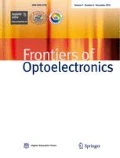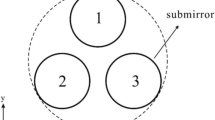Abstract
A reflective optical system is not affected by chromatic aberration, so it has a wide range of applications. Based on the design theory of reflective zoom system with three mirrors, this paper presents the simulation, optimization, and image quality evaluation of the traditional offaxis three-mirror zoom system and freeform off-axis threemirror reflective zoom system.. In these systems, the optical design was aided by software CODEV. Through the analysis of aberrations and structural performance for the traditional aspherical off-axis three-mirror system, the freeform surface was introduced to the tertiary mirror to improve the balance capacity for optical aberrations. This off-axis three-mirror reflective zoom system based on freeform surface could provide technical reference to the study of such systems.
Similar content being viewed by others
References
Zhu J, Hou W, Zhang X D, Jin G F. Design of a low F-number freeform off-axis three-mirror system with rectangular field-of-view. Journal of Optics, 2015, 17(1): 015605
Fuerschbach K, Rolland J P, Thompson K P. Theory of aberration fields for general optical systems with freeform surfaces. Optics Express, 2014, 22(22): 26585–26606
Xue D L, Zheng L G, Zhang F. Off-axis three-mirror system based on freeform mirror. Optics and Precision Engineering, 2011, 19(12): 2814–2815
Zhenrong Z, Xiang H, Xu L. Freeform surface lens for LED uniform illumination. Applied Optics, 2009, 48(35): 6627–6634
Chen E G, Yu F H. Design of LED-based reflector-array module for specific illuminance distribution. Optics Communications, 2013, 289: 19–27
Cheng D, Wang Y, Xu C, Song W, Jin G. Design of an ultra-thin near-eye display with geometrical waveguide and freeform optics. Optics Express, 2014, 22(17): 20705–20719
Yang B, Wang Y T. Computer-aided design of freeform reflector. Acta Optica Sinica, 2004, 24(6): 721–724
Cheng D W, Wang Y T, Chang J, Liu Y, Xu K. Design of lightweight and wide field-of-view HMD system with free-formsurface prism. Hongwai Yu Jiguang Gongcheng, 2007, 36(3): 309–311 (in Chinese)
Zhan T C, Wang Y T, Chang J, Talha M M. Design of reflective zoom system with three mirrors. Acta Optica Sinica, 2010, 30(10): 3034–3038 (in Chinese)
Zhang T C, Wang Y T, Chang J. Design of unobscured reflective zoom system with three mirrors. Chinese Optics Letters, 2010, 8(7): 701–705
Author information
Authors and Affiliations
Corresponding author
Additional information
Guijuan Xie obtained her bachelor’s degree in optical information science and technology from Anhui University in 2013, and she has been a M.S. candidate at School of Optoelectronics, Beijing Institute of Technology since 2013. Her current research is optical design.
Jun Chang is a Professor and Ph.D. Supervisor of School of Optoelectronics at Beijing Institute of Technology. He received his Ph.D. degree in optics from Changchun University of Science and Technology in 2002. He has 13 years experience in reflective zoom optical system, reflective zoom optical system based on active optics, the high precision detection of the offset state of micro system assembly, the design of the universal compensator for testing aspheric surfaces and short baseline distance and long detecting distance measurement with binocular vision based on Opencv. He is the author of more than 60 journal papers. His current interests include optical design and measurement, and electro-optical countermeasures.
Ke Zhang obtained her bachelor’s degree from Department of Physics, Changchun University of Science and Technology in 2006, and M.S. degree in 2009. Since 2013, she has been a Ph.D. candidate at School of Optoelectronics, Beijing Institute of Technology. Meanwhile, she is an engineer at China North Vehicle Research Institute, mainly responsible for optical structure design of aiming system and photoelectric countermeasure system. Her current research is optical design.
Jide Zhou obtained his bachelor’s degree in optical information science and technology from Huadong East China Jiaotong University in 2013, and he has been a M.S. candidate at School of Optoelectronics, Beijing Institute of Technology since 2013. His current research is optical design.
Yajun Niu obtained his bachelor’s degree in optoelectronic information engineering from Beijing Institute of Technology in 2012, his M.S. degree in optical engineering from Beijing Institute of Technology in 2014. Since 2014, he has been a Ph.D. candidate in optical engineering at Beijing Institute of Technology, where his research interests include optical design, testing, and super-resolution imaging.
Rights and permissions
About this article
Cite this article
Xie, G., Chang, J., Zhang, K. et al. Off-axis three-mirror reflective zoom system based on freeform surface. Front. Optoelectron. 9, 609–615 (2016). https://doi.org/10.1007/s12200-015-0515-x
Received:
Accepted:
Published:
Issue Date:
DOI: https://doi.org/10.1007/s12200-015-0515-x




